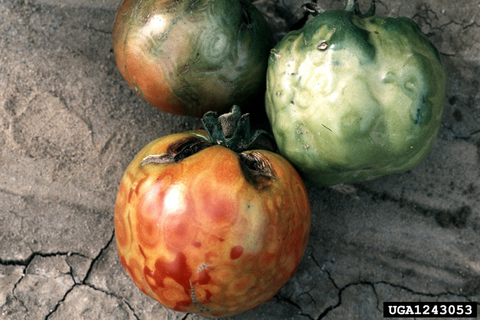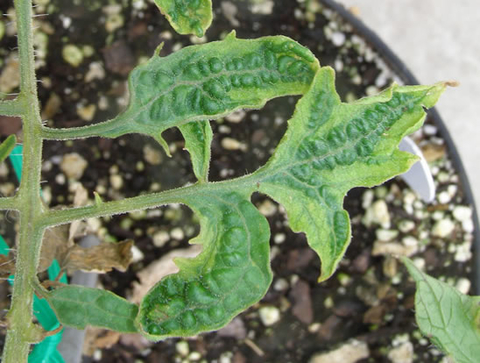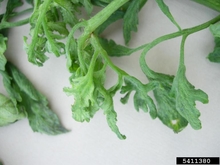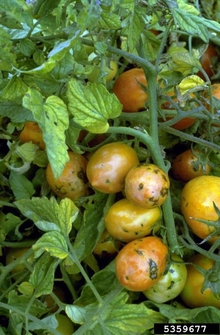Quick facts
- There are more than a dozen viruses that can infect tomatoes.
- The most common viruses in Minnesota are tomato mosaic virus (ToMV) and tobacco mosaic virus (TMV).
- Viruses can cause foliar and fruit symptoms.
- Plant viruses can only be identified by lab testing.
- There is no cure for plant viruses, management actions should be focused on preventing virus spread.
How to tell viruses apart from other tomato issues
Many viruses produce similar symptoms.
- If plants are infected early, they may appear yellow and stunted overall.
- Mottled light and dark green on leaves.
- Leaves may be curled, malformed, or reduced in size.
- Spots of dead leaf tissue may become apparent with certain varieties at warm temperatures.
- Fruits may ripen unevenly.
- Reduced fruit number and size.
- Fruit with raised or depressed off-color circles on fruit.
- Fruits may show internal browning just under the skin (brownwall).
Viruses can be very hard to tell apart from each other, the naked eye can only diagnose that an issue is potentially caused by a virus. Getting a firm diagnosis can only be accomplished by submitting a sample to a lab such as the University of Minnesota Plant Disease Clinic.
Biology
There are many viruses that can infect tomatoes. They are often capable of infecting many other species of plants as well. For example, tomato mosaic virus most often infects tomatoes, but can also infect pepper, potato, apple, pear, cherry and numerous weeds, including pigweed and lamb's quarters.
Tobacco mosaic virus can infect ornamentals and weeds including cucumber, lettuce, beet, pepper, tomato, petunia, jimson weed and horsenettle. The symptoms for each virus on each host appear differently, though there are some commonalities.
Each species of virus has its own specific biology.
- The source of the virus can be other plants, plant debris, seeds and insects.
- Thrips and aphids spread some viruses, especially in transplant production settings.
- Hands, tools and clothes can spread viruses when doing normal activities like plant tying, removing suckers and harvesting.
Managing tomato viruses in the home garden
Monitor your garden for tomato viruses
- Many viruses cause similar symptoms, but it is impossible to confirm without a diagnosis from a plant pathology lab.
- Herbicide damage from products used on lawns can often be mistaken for viruses in home gardens. For information on this, see Herbicide injury on garden plants.
- You also can send plants to the University of Minnesota Plant Disease Clinic for diagnosis.
Resistant varieties
- There are resistant varieties available for some tomato viruses.
- Look for abbreviations like ToMV and TMV in your seed catalog, as well as specific catalog codes for disease resistance.
- No variety can completely protect plants from all tomato viruses.
Physical controls
Remove plants that you suspect may be infected with a virus so they do not spread the virus in the garden. Do not compost them.
Managing tomato viruses on farms
Monitor for tomato viruses
Scout plants regularly. If plants displaying symptoms of viruses are found, remove the entire plant (including roots), bag the plant, and send it to the University of Minnesota Plant Disease Clinic for diagnosis.
Resistant varieties
- There are numerous tomato varieties that are resistant to one or the other of the viruses. These are usually denoted in seed catalogs, often with the code ToMV after the variety name if resistant to tomato mosaic virus and TMV if resistant to tobacco mosaic virus.
- There are only a few varieties that are resistant to both viruses.
- Several popular rootstocks for grafted tomatoes can also confer resistance to varieties that may not normally be resistant.
- An extensive list of resistant tomato varieties can be found on the Cornell University Vegetable website.
Cultural practices
Start the season with un-infected transplants
- Use certified disease-free seed or treat your own seed.
- Soak seeds in a 10% solution of trisodium phosphate (Na3PO4) for at least 15 minutes.
- Heat dry seeds to 158 °F and hold them at that temperature for two to four days.
- Hot water treatment is not adequate for some tomato viruses.
- Purchase transplants only from reputable sources. Ask about the sanitation procedures they use to prevent disease.
- Inspect transplants prior to purchase. Choose only transplants showing no clear symptoms.
- Avoid producing transplants in greenhouses that also contain perennial ornamentals, as they can be a reservoir of viruses.
Rotation
- Avoid planting in fields where tomato root debris is present, as the virus can survive long-term in roots.
Prevent and slow the spread of viruses
- Wash hands with soap and water before and during the handling of plants to reduce potential spread between plants.
Good sanitation
- Disinfect tools regularly — ideally between working on each plant, as plants can be infected before showing obvious symptoms.
- Soaking tools for 1 minute in a 1:9 dilution of germicidal bleach is highly effective.
- A 1-minute soak in a 20% weight/volume solution of nonfat dry milk and water is effective for some viruses.
- When pruning plants, have two pruners and alternate between them to allow proper soaking time between plants.
- Avoid using tobacco products around tomato plants, and wash hands after using tobacco products and before working with the plants. Tobacco in cigarettes and other tobacco products may be infected with either ToMV or TMV, both of which could spread to the tomato plants.
- If a virus is confirmed, employ stringent sanitation procedures to reduce spread to other plants, fields, tunnels and greenhouses.
- Completely pull up and burn infected plants. Do not compost infected plant material.
- After working with diseased plants, thoroughly disinfect all tools and hands as outlined above.
- For added security against spread, keep separate tools for working in the diseased area and avoid working with healthy plants after working in an area with diseased plants.
- At the end of the season, burn all plants from diseased areas, even healthy-appearing ones, or bury them away from vegetable production areas.
- Disinfect stakes, ties, wires or any other equipment between growing seasons using the methods noted above.
Using pesticides
There are currently no chemical options that are effective against either virus. Management of aphids and thrips during transplant production can help reduce the spread of plant viruses.
Reviewed in 2021





